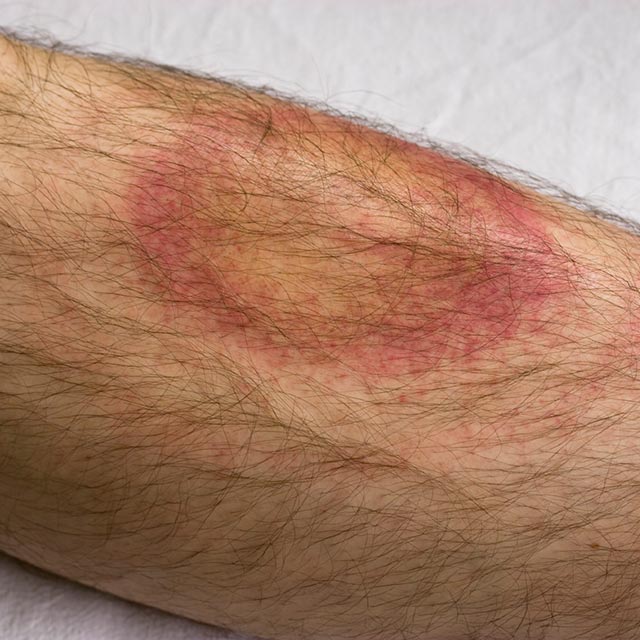Ticks and Lyme Disease
Ticks and Lyme Disease
What You Need to Know About Lyme Disease

-
Lyme disease is an infection caused by the spiral-shaped bacteria Borrelia burgdorferi, which is most commonly transmitted by a tick bite.
-
There are over 300,000 estimated new cases of Lyme disease in the United States each year.
-
The symptoms of Lyme disease depend on the how long the infection has been present in the body. The first sign of Lyme disease is often an expanding round or oval red "bullseye" rash.
-
If left untreated, people may develop neurological symptoms and heart problems, and have an approximately 60 percent chance of developing Lyme arthritis.
What is Lyme disease?
Lyme disease is an infection caused by the bacteria Borrelia burgdorferi. This spiral shaped bacterium is most commonly spread by a tick bite. The disease takes its name from Lyme, Connecticut. This is where the illness was first identified in the United States in 1975.
Although Lyme disease is a year-round problem, April through October is considered tick season. Cases of Lyme disease have been reported in nearly all states in the U.S. and in large areas in Europe and Asia, but the most common areas are the Northeast, upper Midwest and northwestern states.
What causes Lyme disease?
Lyme disease is caused by bacteria that is spread to humans by tick bites. The ticks that carry the spirochete are:
-
Black-legged deer tick (northeastern, mid-Atlantic, and North-Central U.S.)
-
Western black-legged tick (Pacific coastal U.S.)
Ticks prefer to live in wooded areas, low-growing grasslands, and yards. Not all ticks carry the Lyme disease bacteria. Depending on the location, anywhere from less than 1% to more than 50% of the ticks are infected with it.
While most tick bites are harmless, several species can cause life-threatening diseases. Tick-borne diseases include:
-
Rocky Mountain spotted fever
-
Lyme disease
-
Anaplasmosis
-
Babesiosis
-
Colorado tick fever
-
Powassan encephalitis
-
Tularemia
-
Ehrlichiosis
-
Relapsing fever
Who is at risk for Lyme disease?
Factors that can increase your risk for getting Lyme disease include:
-
Working or spending time outdoors in areas where the black-legged deer tick or Western black-legged deer tick is found
-
Having pets that can bring the ticks into the home
What are the symptoms of Lyme disease?
The list of possible symptoms is long, and symptoms can affect every part of the body. The following are the most common symptoms of Lyme disease. But symptoms are slightly different for each person.
The primary symptom is a red rash that:
-
Can appear several days after infection, or not at all
-
Can last up to several weeks
-
Can be very small or grow very large (up to 12 inches across), and may resemble a "bulls-eye"
-
Can mimic such skin problems as hives, eczema, sunburn, poison ivy, and flea bites
-
Can itch or feel hot, or may not be felt at all
-
Can disappear and return several weeks later
Several days or weeks after a bite from an infected tick, you may have flu-like symptoms such as the following:
-
Headache
-
Stiff neck
-
Aches and pains in muscles and joints
-
Low-grade fever and chills
-
Fatigue
-
Poor appetite
-
Swollen glands
Weeks to months after the bite, the following symptoms may develop:
-
Neurological symptoms, including inflammation of the nervous system (meningitis) and weakness and paralysis of the facial muscles (Bell palsy)
-
Heart problems, including inflammation of the heart (myopericarditis) and problems with heart rate
-
Eye problems, including inflammation (for example, red eye)
Months to a few years after a bite, the following symptoms may include:
-
Inflammation of the joints (arthritis)
-
Neurological symptoms including numbness in the extremities, tingling and pain, and difficulties with speech, memory, and concentration
Some people may develop post-Lyme disease syndrome (PLDS). A condition also known as chronic Lyme disease includes PLDS, but also other syndromes. Usually, these are characterized by persistent musculoskeletal and peripheral nerve pain, fatigue, and memory impairment.
How is Lyme disease diagnosed?
Lyme disease is difficult to diagnose because symptoms are not consistent and may mimic other conditions. The primary symptom is a rash, but it may not be present in up to 20% of cases.
Diagnosis for Lyme disease must be made by a healthcare provider experienced in recognizing Lyme disease. Diagnosis is usually based on symptoms and a history of a tick bite. Testing is generally done to confirm the diagnosis and rule out other conditions. This may need blood and other lab tests.
Research is underway to develop and improve methods for diagnosing Lyme disease.
The symptoms of Lyme disease may look like other medical conditions or problems. Always talk with your healthcare provider for a diagnosis.
How is Lyme disease treated?
Your healthcare provider will figure out the best treatment for you based on:
-
How old you are
-
Your overall health and past health
-
How sick you are
-
How well you can handle specific medicines, procedures, or therapies
-
How long the condition is expected to last
-
Your opinion or preference
Lyme disease in the earliest stage is usually treated with antibiotics for 2 to 3 weeks.
Treatment will also be considered based on these and other factors:
-
If you are bitten by a tick that tests positive for the bacteria that causes Lyme disease
-
If you are bitten by a tick and have any of the symptoms
-
If you are bitten by a tick and are pregnant
-
If you are bitten by a tick and live in a high-risk area
What are the complications of Lyme disease?
Lyme disease affects people differently. Relapse and incomplete treatment responses happen. Relapse and incomplete treatment responses happen. Complications of untreated early-stage disease include:
-
Joint disease
-
Neurologic disease
-
Heart inflammation
-
Frequent hospitalizations to manage the disease
Some of these complications result in chronic, debilitating conditions.
Some people may develop post-Lyme disease syndrome (PLDS). A condition also known as chronic Lyme disease includes PLDS, but also other syndromes. Usually, these are characterized by persistent musculoskeletal and peripheral nerve pain, fatigue, and memory impairment.
Can Lyme disease be prevented?
People aren't able to become immune to Lyme disease. So even if you've had Lyme disease, you can get it again. No vaccine is available currently to prevent the disease.
The FDA approved a Lyme vaccine called LYMErix in 1998. The vaccine was not 100% effective, however. The FDA still recommended preventing the disease in other ways. In 2002, the company that made LYMErix said it would no longer offer the vaccine.
To help prevent Lyme disease, follow these guidelines.
Clothing
Dress appropriately by wearing:
-
Light-colored clothing
-
Long-sleeved shirts
-
Socks and closed-toe shoes
-
Long pants with legs tucked into socks
Checking for ticks
Look for ticks often on:
-
All joints: behind the knees, between fingers and toes, and on underarms
-
Other areas where ticks are commonly found: belly button, neck, hairline, top of the head, and in and behind the ears
-
Areas of pressure points, including anywhere that clothing presses tightly on the skin
Visually check all other areas of the body, and run fingers gently over skin.
Insect repellents
Consider using repellents. Remember to use all repellents safely.
-
Products that have DEET repel ticks, but they don't kill them. These products aren't 100% effective in keeping a tick from feeding on you.
-
Products that have permethrin do kill ticks. But they should be sprayed only on clothing, not on your skin.
Other measures
These other methods may also help:
-
Shower after all outdoor activities are over for the day.
-
Check pets and children for ticks.
What should you do if you find a tick?
-
Don't touch the tick with your bare hand.
-
Use a pair of tweezers to remove the tick. Grab the tick firmly by its mouth or head as close to your skin as possible.
-
Pull up slowly and steadily without twisting until it lets go. Don't squeeze the tick, and don't use petroleum jelly, solvents, knives, or a lit match to kill the tick.
-
Save the tick. Place it in a plastic container or bag so it can be tested for disease, if needed.
-
Wash the bite area well with soap and water and put an antiseptic lotion or cream on the site.
-
Call your healthcare provider to find out about follow-up care and testing of the tick for the Lyme disease bacteria.
When should I call my healthcare provider?
If your symptoms get worse or you have new symptoms, let your healthcare provider know.
More Information About Lyme Disease from Johns Hopkins Medicine


